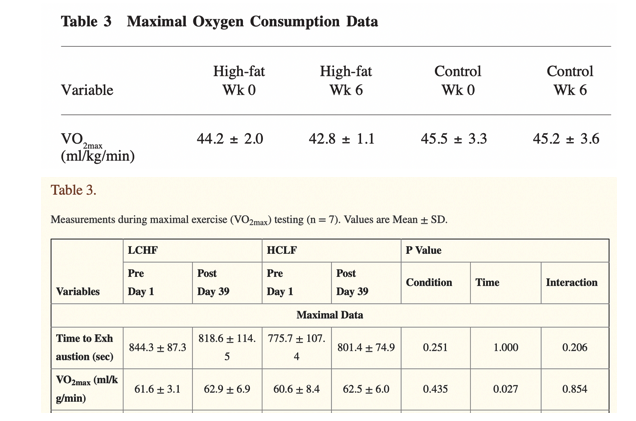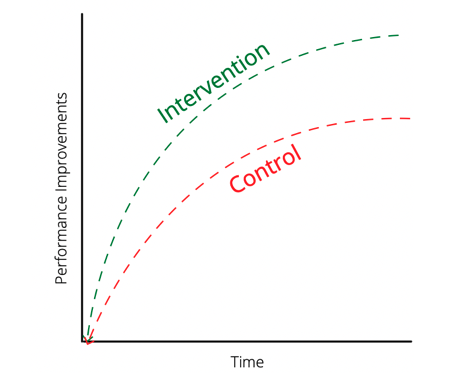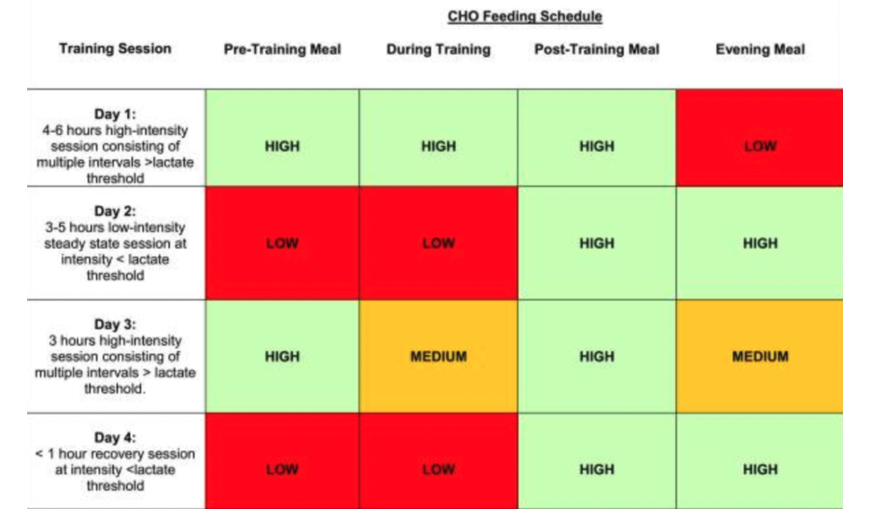Background
Traditional fuelling strategies for maximising endurance performance have emphasised high carbohydrate diets during both training and competition periods. A reliance on carbohydrates as a fuel source, particularly for higher exercise intensities, has always been at the centre of this argument. However, in recent years, scientific research and athletes themselves have shown a growing interest in low carbohydrate diets to improve their adaptations to training and their performance on competition day. Underlying this interest are numerous mechanisms and metabolic adaptations induced by low carbohydrate diets that are speculated to translate to improved endurance performance. An increase in fat oxidation and ketone availability to fuel exercise at submaximal intensities are at the top of the list for possible mechanisms of benefit, especially when they are thought to spare carbohydrate stores (glycogen) for event-winning moments. In this regard, low carbohydrate diets are posing a challenge to what we know of fuelling strategies, and one that will continue to be addressed in the coming years. The ketogenic diet is at the centre of this debate as it is the dietary extreme of low carbohydrate diets, with daily energy intake comprised of around 75-80% fat, 15% protein, and 10% or less from carbohydrates. Some interesting research findings of the ketogenic diet alongside a few examples of well-performing ketogenic athletes in elite sport has only increased interest in the question – do we really need carbohydrates to perform at our best?
In this article, we aim to explore this question in regard to endurance performance. Defining what constitutes ‘endurance’ is somewhat subjective and could have an article of its own, but for simplicity, we are defining it as an event that involves submaximal intensities and lasts for over 30 minutes. The word ‘performance’ is less subjective because it speaks only to what really matters in the real world: outcomes. Although a range of metabolic modifications have been attributed to the ketogenic diet, whether they translate to better (or worse) endurance outcomes is an entirely different question and a more important one too. While we will be posting more articles to My Nutrition Science about the mechanisms by which ketogenic diets are thought to be superior—including a comprehensive look at our fundamental understanding of energy systems—here we break down the key evidence for ketogenic diets and endurance outcomes.
Finally, a Meta-Analysis
Not until the year has a meta-analysis of the relevant studies on ketogenic diets and endurance outcomes been performed. The number of studies to assess this topic has basically been too scarce to consider collectively until now, and arguably this is still the case based on the large differences in methodologies between studies. But, since we have one, so let’s roll with it. This meta-analysis comes from Cao et al. [1] and at least provides a good overview of the most robust studies to date in the area. Studies that were included in the meta-analysis had to be interventions of some kind—either randomised or nonrandomised—in endurance athletes who regularly trained at submaximal intensities. In addition, the included studies had to be tests of a ketogenic diet (≤10% CHO and ≥60% fat) against a control diet (higher-carbohydrate diet; ≥40% CHO and ≤40% fat) as confirmed by reliable methods of dietary collection (food diaries or recalls), implement submaximal intensity exercises, and also include a graded exercise test to measure changes in VO2max reliably. Such strict inclusion criteria, notably the latter mention, inevitably wiped out most of the literature on ketogenic diets and performance; only 10 studies were eligible for analysis, composed of 4 crossover randomised controlled trials (RCTs) and 6 control studies. All 10 studies looked at differences in VO2max between the ketogenic diet and a higher carbohydrate diet, while some proportion of these studies also allowed for analysis of time-to-exhaustion tests, maximal heart rate tests, and ratings of perceived exertion during the graded exercise test.
First up, let’s take a look at the results for VO2max. You might already be thinking that VO2max isn’t a direct measure of endurance performance, and you would be correct, but it is known to be one of the best predictors of endurance performance. A concise and accurate definition of VO2max comes from Evan Peikon [3] stating that, “VO2max represents the maximum integrated capacity of the pulmonary, cardiovascular, and muscular system to uptake, transport, and utilize oxygen”. And within this meta-analysis, the results for dietary effects on VO2max were extremely clear-cut without much room for interpretation. It showed no significant differences in VO2max between the ketogenic and higher-carbohydrate diets with extremely low heterogeneity. The low heterogeneity is particularly important here as it means the studies analysed were largely in agreement with one another, despite the (reasonably large) differences in their study design such as exercise type, intensity, and duration. The length of each intervention also differed a fair amount; most interventions were between 2-6 weeks while Burke et al. [4] had a short intervention of just 5 days, and Dostal et al. [5] had an intervention of 12 weeks. Despite this, neither study found significant differences between the ketogenic and higher-carbohydrate diets, and excluding either of these studies from the meta-analysis would not have changed the interpretation of the results. It is actually because study methodologies differed yet all reported the same results—with almost identical confidence intervals—that we can confidently state VO2max does not change significantly due to variances in carbohydrate intake.

A major point to keep in mind here is that VO2max is only one predictor of endurance performance, albeit a good one. Especially in well-trained athletes, as included in this meta-analysis, baseline VO2max will already be high, and we must acknowledge that individuals can improve their endurance performance independent of changes in VO2max. For example, an athlete can increase what fraction of their VO2max can be sustained over time, called performance VO2, without actually increasing their VO2max [6]. This is especially important considering that for endurance events over 10 minutes, elite athletes will perform within the range of 75-85% VO2max for the majority of the time, with only a small proportion of the event performed above 90% VO2max [7]. This means that although the lack of VO2max differences between diets is an important point, it should not be the only variable that influences our position on the general topic of what constitutes ‘endurance performance’.
The other additional point worth mentioning for VO2max here is that 8 of the 10 included studies reported only absolute VO2max changes rather than including relative VO2 changes. We have heard this being a point of contention as ketogenic diets are a good weight loss strategy—at least in the short-term when adhered to—and only the relative VO2max accounts for bodyweight change during the intervention (quantifying oxygen consumption per unit of mass rather than only the total amount of oxygen consumed). However, there is not much to see here anyway because if we look at the 2 studies that did include measurements of relative VO2max changes—Fleming et al. [8] and Prins et al. [9]—neither the ketogenic diet nor the higher carbohydrate diets significantly increased relative VO2max from baseline.

Next up, the meta-analysis looked at time-to-exhaustion. This is a more direct measure of endurance performance than VO2max as it measures an athlete’s capacity to sustain a fixed workload for a set duration of time. However, this meta-analysis’s problem with time-to-exhaustion tests was that not many studies actually looked at this measure with a robust methodology. Consequently, only 3 of the 10 studies (48 participants total) provided relevant data. Interpreting these results with caution is warranted due to the data’s susceptibility to variation when more data becomes available. Based on the limited data for now, we can see that much like is the case for VO2max, there is no significant overall difference in time-to-exhaustion between ketogenic diets and high-carbohydrate diets, again with a considerable agreement between studies as indicated by low heterogeneity. The concordance of this result with the last variable, VO2max, gives us more confidence that these represent a lack of true differences in endurance performance despite the lack of studies used for this analysis.

Where some differences are found in the Cao et al. [1] meta-analysis is regarding the maximal heart rate and the ratings of perceived exertion during the graded exercise test for determining VO2max. Although once again there is no significant overall difference between diets for this particular outcome, we can at least see some heterogeneity in the results of individual trials, which, as we previously stated, is probably what we would expect when the study methodologies are so different.


This at least allows us to go a bit deeper into the studies and ask the simple question – why are some results different from others? To answer this, it’s good to look at the studies which reported significant differences in favour of opposing dietary protocols. For heart rate max, Burke et al. [4] and Dostal et al. [5] had results that opposed a later study from Burke et al. [10]. However, it seems as though there was a data entry issue here as the earlier Burke et al. [4] study was in agreement with the later study that ketogenic diets increase heart rate during graded economy tests, indicating higher metabolic costs than higher carbohydrate diets. There was also a significant difference in heart rate max in the Dostal et al. [5] study favouring higher-carbohydrate diets—not ketogenic diets—that was not accurately represented in this meta-analysis. Thus, there was more agreement among the included studies than suggested by Cao et al. [1], and although together they suggest no significant difference between diets, any nonsignificant differences tend to be in favour of higher-carbohydrate diets. This may support the hypothesis that ketogenic diets increase metabolic stress due to higher neurological efforts and increased sympathetic nervous system activity during intense exercise [11] – essentially increasing the perceived and real exertion experienced by athletes.
For ratings of perceived exertion during the graded exercise test, the Dostal et al. [5] and later Burke et al. [10] study were again reported to find significant differences but in opposite directions. We believe this might be explained by the type of graded exercise test used in either trial. Both used a motorised treadmill, but the test in Burke et al. [10] comprised short submaximal stages of race walking, with each stage immediately followed by an incremental ramp to exhaustion. In contrast, Dostal et al. [5] used a more linear graded test protocol, starting at 7km/hour and increasing the speed by 1.5 km/hour every 4 minutes until volitional exhaustion. This subsequently meant the Burke et al. [10] protocol used more frequent intermittent periods of high-intensity exercise, which could explain the contrasting differences in ratings of perceived exertion between trials. Also, in Dostal et al. [5], the ketogenic diet group had higher ratings of perceived exertion at baseline compared to the higher-carbohydrate group (17.8 vs 16.1) and, after the 12-week intervention with either diet, the post-intervention ratings were virtually identical (18.8 vs 18.7). This suggests that the scope for improvement for this variable was greater in the ketogenic diet group at baseline, which could explain their greater improvements from pre- to post-intervention on this occasion.
As a side note, we will also point out another error in this meta-analysis for ratings of perceived exertion. Although the data plugged into the meta-analysis suggested that Cipryan et al. [12] saw a non-significant reduction from the ketogenic diet during the graded exercise test, this wasn’t the case. Cipryan et al. [12] didn’t even measure ratings of perceived exertion during their graded exercise test; the researchers only measured the ratings of perceived exertion during high-intensity interval training sessions before, during, and after the intervention, where virtually no differences between diets were found at any time point. Removing the Cipryan et al. [12] result would have pulled the overall result of these studies toward favouring higher-carbohydrate diets more strongly, although we’re unsure whether this would have resulted in a significant difference in favour of high-carbohydrate diets.
In summary, although this meta-analysis reported significant differences in substrate utilisation as a fuel source during submaximal exercise—the only measure that we haven’t discussed— there were ultimately no significant differences in endurance performance, or predictors of performance, to support the superiority of ketogenic or higher-carbohydrate diets strongly. Some indications for greater heart rate max and rating of perceived exertion during graded exercise tests are possible concerns for ketogenic diets that we will refer back to shortly.
Systematic Reviews to Corroborate the Meta-Analysis Results
A criticism of the previously discussed meta-analysis is that its exclusion criteria did not allow for some highly-cited studies to be included. Therefore, to further support the meta-analysis results, we can also take a look at the latest relevant systematic review published in the area from Murphy et al. [13]. They conducted a systematic review of ketogenic diets in relation to physical performance, dedicating an entire section of the analysis specifically to endurance outcomes. Their inclusion criteria were similar to Cao et al. [5] in that they were only looking at interventional studies comparing ketogenic diets against higher-carbohydrate diets for over 2 training weeks in healthy adults. However, due to minor differences in the exclusion criteria, there were some differences in the studies analysed: Murphy et al. [13] included a study on untrained athletes by Sjodin et al. [14], and a few well-known interventional trials by Phinney et al. [15], McSwiney et al. [15] and Zinn et al. [16]. These additional interventional studies used either time-to-exhaustion or time trials to assess endurance performance. The latter is a test that replicates competitive events by timing how fast individuals complete a set course or distance. What was also generally different about this systematic review compared to the Cao et al. [5] meta-analysis is that it accounted for training status as dichotomised by the median VO2max across studies: <53 mL/kg/min and ≥53 mL/kg/min. Differences in training status were not considered in Cao et al. [5] as they only included studies on trained endurance athletes, and this is an important point to note as trained athletes are less susceptible to training improvements than untrained athletes.
In total, Murphy et al. [13] reported 7 performance outcomes in studies with high VO2max participants: 6 (3 time trials, 3 time-to-exhaustion) reported no differences between diets, and 1 (time trial) reported worse endurance performance when consuming a ketogenic diet. There were also 6 performance outcomes in studies with low VO2max participants: 4 (1 time trial, 3 time-to-exhaustion) reported no difference between diets, and 2 (time-to-exhaustion) reported worse endurance performance when consuming a ketogenic diet. So overall, no major differences to make any strong inferences dissimilar to Cao et al. [5]. But this being said, it is perfectly reasonable to start questioning the possible differences between the majority of studies showing no differences and the few showing a detrimental impact of ketogenic diets. For this reason, we have taken a look at these studies to check for important differences in methodology or analysis, but there is nothing that we can find at this point. Differences in exercise intensities would probably be an assumed difference between studies, but it does not appear to be; all performance tests were distributed within the intensity range of ~50-80% VO2max or VO2peak—the latter being the maximum oxygen consumption during a specific test but not necessarily reflective of an individual’s maximum oxygen uptake as with VO2max.
As the included studies in this systematic review also differed in duration from 21-84 days and some keto proponents claim that “fat adaptation” may require a longer duration than this, it’s also good to see that this systematic review separated studies into subgroups of duration to look for possible differences. However, again, no considerable differences were found when the studies were separated in this manner. With the exception of one study, it didn’t matter where the study duration sat between 21–84 days, as the ketogenic diet still only resulted in the same or worse endurance outcomes compared with higher-carbohydrate diets. As the one exception happened to be a study at the upper end of the range here (84 days), this, of course, gives keto proponents a glimmer of hope to suggest that all these studies were not long enough to see the true benefits. The authors of this study, McSwiney et al. [15], even suggested this themselves by reporting a possible “lag” in performance improvements when transitioning to a ketogenic diet. But the reality is that there are many other plausible explanations for why this study appears to be an outlier that has nothing to do with study duration. Probably the most important confounder is that the ketogenic diet group had significantly higher bodyfat levels at baseline and lost ∼4 kg of bodyfat during the intervention. Another issue is that 7 of the 16 subjects did not actually complete the post-intervention testing in the ketogenic diet group, which indicates reporting bias as the results may only include those who responded positively to the ketogenic diet. Third, unlike all the other studies in this systematic review, the control group used carbohydrate intakes that did not meet the guidelines for the event they were testing (100km time trial), which unreasonably reduces the contrast in carbohydrate intake between groups.
Are All These Studies Just Not Long Enough to Find Differences?
We await the comments… “All the studies still just aren’t long enough, bro”. While it is technically possible that all the studies are too short to measure differences that would otherwise show with longer durations, we think it’s improbable. Why it’s technically possible is because performance improvements in trained athletes are relatively minor under 84 days, any hypothetical differences in performance between diets would become more noticeable with time. We have demonstrated this on the graph below, assuming a dietary intervention were superior–longer study durations allow for greater differences in performance improvements to be measured.

However, the thing is that even in the hypothetical that either diet reigns supreme over extended timeframes, we have little basis for speculating about which type of diet would actually come out on top. Assuming ketogenic and “fat-adapted” athletes will best higher-carbohydrate athletes over the long haul is just as much speculation as suggesting that higher-carbohydrate athletes will edge out the win. To solidify this point, we only need to look at data on the primary mechanism thought to result in superior performance with ketogenic diets: higher mean and maximal fat oxidation rates. For example, in the longer McSwiney et al. [15] and Prins et al. [9] studies that measured changes in fat oxidation rates over 0-6 weeks versus 6-12 weeks, more prolonged exposure to the ketogenic diet did not increase fat oxidation rates beyond 3–4 weeks. There was a substantial and obvious initial change when switching diets as expected, but no further change thereafter. Moreover, if we look at long-term observations of endurance athletes exposed to a ketogenic diet for 8-26 months—such as from Webster et al. [16] and Volek et al. [17]—the mean and maximum fat oxidation rates are still in the ballpark of that observed after 3-4 weeks of the initial ketogenic transition. Therefore, unless different information on processes and time course of substrate shifts during keto-adaptation become available, we can assume the studies in the discussed meta-analysis and systematic review are sufficient to pass judgement on ketogenic diets when “fat-adapted”. The only caveat to this is if a different mechanism indicates we need longer study durations to test ketogenic diets fairly. For example, Volek et al. [17] make the case that upregulating gluconeogenesis on a ketogenic diet to achieve comparable glycogen stores to higher-carbohydrate diets may take months. How important this proposal is, who knows, but hopefully, time will tell.
Exercise Intensity and Economy Matters?
To expand on a prior point that ketogenic diets may increase heart rate max and ratings of perceived exertion during graded exercises tests, we want to touch on a claim mentioned throughout the literature: that ketogenic diets ‘reduce exercise economy’ compared to higher-carbohydrate diets. This means that ketogenic diets are thought to lower the efficiency of energy production, measured as the volume of oxygen required to move at a given speed, power output, or work rate. This narrative goes back almost 100 years when Krogh and Lindhard [18] measured an increased oxygen cost of producing ATP from the oxidation of fat relative to carbohydrate. Many experts in sports sciences still use this as a reason to suggest the potential issues with following a ketogenic diet when exercise intensities and energy demands are high.
However, the relevance of this point for suggesting that ketogenic diets reduce endurance performance does not appear to be as well-supported in the literature as some experts suggest. Based on the meta-analysis and systematic review that we have discussed in this article, any differences in exercise economy between diets do not consistently translate to worse endurance outcomes, even when exercise intensities are higher within the submaximal range. We can even look at individual studies to support this point further. For example, Shaw et al. noted no differences in measured oxygen uptake or other predictions of oxygen cost at exercise intensities <60% VO2peak, but they did find reduced exercise economy at exercise intensities >70% VO2peak. Still, endurance performance was not significantly different between diets despite this (time-to-exhaustion and distance-to-exhaustion tests were not significantly different). This might seem counterintuitive considering that both the modelling [19] and measures [20] of exercise economy clarify its importance for endurance, but if this doesn’t present itself in the evidence directly, then it is okay to raise questions. There are even findings from Prins et al. [9] which contest differences in exercise economy between diets at all. The researchers found that during a series of 5km time trials during 6 weeks of ketogenic or higher-carbohydrate diets, there were no differences in oxygen uptake or performance other than in the 1st time trial after just 4 days of ketogenic adaptation. This was despite the exercise protocol taking place at an oxygen cost of ∼80% VO2peak where differences in exercise economy have been proposed.
To our knowledge, the only group of studies that have found a simultaneous reduction in exercise economy and endurance performance are all from Burke et al. [4] [10] [21] in studies conducted on elite race walkers. In these studies, the oxygen cost of race walking at speeds approximating race pace in 10k, 20km, and the 50km events (~75-90% VO2peak) was significantly increased with the ketogenic intervention. In addition, these studies found a lack of performance improvements from pre- to post-intervention with ketogenic diets, while diets that maintained high carbohydrate availability (sometimes significantly) improved performance measures:
- The first study from this research group was conducted in elite race walkers, investigating the performance effects of a 3-week period of intensified training paired with a ketogenic diet [4]. 3 weeks of fat adaptation demonstrated significantly elevated rates of fat oxidation during exercise at 80% of their VO2 peak; however, the oxygen cost of exercise was significantly increased whereas it was reduced in higher-carbohydrate groups. Presumably due to the differences in exercise economy, the ketogenic diet group failed to improve their 10k time-trial performance after training, whereas the high-carbohydrate and periodised-carbohydrate groups significantly improved their performance.
- In the second study, 5 days of a ketogenic diet in elite male race walkers athletes induced rapid keto-adaptation verified by significantly elevated fat oxidation rates [21]. Despite this, 10km race performance was slower by 3.4% on average—6 of 7 ketogenic athletes experienced impaired performance—while all six athletes in the high carbohydrate group improved performance by an average of 5.7%. In addition, at simulated race paces, the oxygen cost of exercise was 5-8% more in the fat-adapted athletes. The athletes even repeated performance outcome tests after reintroducing a high-carbohydrate diet for 24 hours, yet still did not return to baseline performance, suggesting that the impairments were unrelated to acute carbohydrate availability. The researchers noted, “the economy of exercise at intensities relevant to real life endurance events is reduced by brief adaptation to a ketogenic LCHF when fat oxidation is maximised” (14)
- The most recent study compared a high-carbohydrate, periodised carbohydrate, and ketogenic diet in elite male and female race walkers after a 25-day training/adaptation period [10]. Though VO2peak increased and fat oxidation rates were relatively enhanced in the ketogenic diet group, their baseline 10km race walk performance declined by 2.3%, along with an increased oxygen cost of exercise at race pace. As this study included a larger sample size than previous investigations, the researchers stated, “The opportunity to replicate and extend the protocol of a previous small scale study provides confidence that our findings were robust: despite achieving substantial increases in the capacity for fat oxidation during intense exercise, 3.5 wk adaptation to a ketogenic low-CHO, high-fat diet reduced exercise economy and impaired performance of a real-life endurance event in elite athletes.“
The cumulative evidence from Louise Burke and her research group has led to the suggestion that any performance detriments from a ketogenic diet are a direct result of the oxygen cost of shifting substrate oxidation from carbohydrates to fats, and this is more likely to be meaningful for performance when exercise intensities are higher (>75% VO2max or VO2peak) than what most studies test for. These are interesting and potentially meaningful observations. Even if not consistently reflected in the wider literature, we believe it’s enough of a concern for competitive athletes to weigh up the risk-to-reward ratio when contemplating dietary change. Our concern is only strengthened by the fact that, although most studies find no significant differences between diets, those which do find a difference are disproportionately in favour of higher-carbohydrate diets.
What About Periodising Carbohydrate Intake to Match Energy Needs?
Up until now we have yet to find much of a benefit to adopting a ketogenic diet over a high-carbohydrate diet, despite any theoretical benefits. But what about periodising carbohydrate intake to match the energy demands of the day? Is this a way to access the theoretical benefits of a low carbohydrate diet but also not compromise performance when exercise demands are high? This periodising approach is becoming increasingly popular in sport nutrition and is now known as fuelling for the work required [6] (FTWR). Many elite sports teams now even include this practice in nutrition plans for their athletes. FTWR presents an amalgamation of traditional train-low and compete-high models whereby carbohydrate availability is adjusted according to the demands of the upcoming exercise. The idea of FTWR is that it simultaneously allows for an athlete to optimise (1) training adaptations by enhancing fat oxidation and mitochondrial biogenesis, (2) bodyweight management by tapering carbohydrate intake to better match daily energy demand, and (3) performance during intense training sessions and competition when higher-carbohydrate intakes may be superior. On paper at least, these supposed benefits are obviously quite appealing to a sports nutritionist and we think logically this approach seems to “make sense” for people so to speak. Even experts who oppose ketogenic diets, such as Louise Burke, are proponents of the FTWR approach, making it even more persuasive. An example of an FTWR approach is shown below.

But as always we must not just accept that a nutritional approach is indicated simply because it “makes sense”; we must scrutinise the evidence-base to the same degree as any other dietary approach. And, thanks to a recent meta-analysis from Gejl and Nybo [22] we are now able to gain some good insights into the validity of the FTWR approach. This meta-analysis was focused explicitly on analysing training intervention studies, lasting over a week, that compared periodised carbohydrate restriction (≥3 times per week) to chronically high carbohydrate intakes (control diets). All studies included were performed in trained-endurance athletes (VO2max ≥ 55 and 60 ml/kg/min for females and males, respectively) and measured changes in endurance performance before and after the training period. Unsurprisingly, as with Cao et al. [1], the strict inclusion criteria meant there were only 9 studies used for analysis.
The meta-analysis revealed that the overall effect of periodising carbohydrate availability on performance in well-trained endurance athletes was not statistically significant compared to a chronic high carbohydrate diet. Thus, the meta-analysis did not support periodic carbohydrate restriction as a superior approach for enhancing endurance performance in well-trained athletes.

Based on the test for effect differences between studies, the impact of heterogeneity in the meta-analysis is not reported as important considering the percentage of variation across studies (the I^squared value) was only 12%. This is fairly interesting considering that the measure of endurance performance differed among trials (4 studies used a time trial and 5 studies used power output assessments during a time trial), and there were many different carbohydrate periodisation protocols used (3 studies used a “twice-a-day” training approach, 3 studies used a “sleep-low” approach, 1 study used a standard fasted training strategy, and the remaining 2 studies used a mixture of different strategies). This agreeability among the studies suggests that unconsidered mediating variables are unlikely to be masking a true difference here.
The one study in the meta-analysis which did reach statistical significance happened to use a “sleep low” strategy, which is when carbohydrate intake is restricted after a depleting session on 1 day and then a training session is completed the following morning in a low-carbohydrate state. This study may be used to support this specific method of carbohydrate periodisation as a performance improvement strategy. However, we don’t believe this is appropriate for many reasons, including (1) both of the other “sleep low” studies used in this meta-analysis did not report statistical significance, (2) the “sleep low” group in that particular trial happened to lose a statistically significant amount of bodyweight (-1kg; -1.1% bodyfat) whereas the control group did not, and (3) the higher ratings of perceived exertion during the morning sessions in the carbohydrate periodisation group indicate a possible placebo effect and/or that the control group could have tolerated a higher training load.
As was the case before, it’s also important to mention here that none of the included studies in the meta-analysis surpassed a duration of 4 weeks. It is unlikely that well-trained endurance athletes make great deals of progress in this short space of time, and so this would have reduced the magnitude of (possible) outcome differences between diets if there indeed were any. However, many of the studies included in the meta-analysis did see significant performance improvements from baseline in both intervention and control groups which we feel is enough to avoid using time as a valid excuse to dismiss the lack of benefit found for either dietary approach. Future studies may suggest otherwise, but it would be premature to do so at this point.
Final Thoughts
Although there are many speculated reasons why low and high carbohydrate diets may be superior to one another for endurance performance, there are a lack of reported outcome differences when tested. There is some concern that ketogenic diets can result in reduced exercise economy (with higher heart rates and perceived exertion) at higher exercise intensities in the submaximal range, but this point is not consistently supported. It is wise for elite athletes to consider the potential detriments to following a ketogenic diet, but it is also important to emphasise that any differences in endurance performance are probably overstated based on the current literature. As individual variation is expected, as with anything related to training, athletes interested in a ketogenic diet may wish to experiment without fear of causing major and irreversible damage to their performance. While there is no reason to suggest ketogenic diets are superior for endurance performance, some athletes appear to enjoy this eating style and find it more sustainable. Any notable declines in performance during higher-intensity exercise will make for an obvious indication that athletes should look to reintroduce carbohydrates periodically to match exercise demands, even if current evidence suggests no significant benefit to this approach at the group level. So train hard, train smart, and eat carbs (or don’t!).
If you have enjoyed this article, please consider supporting the site by donating here and subscribing to our email list below (we don’t spam!).






